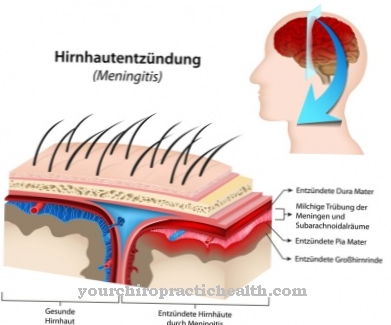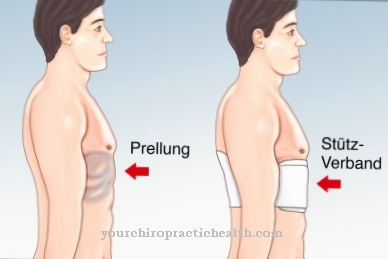Stress incontinence is very uncomfortable for those affected. The involuntarily leaking urine can be collected well with hygienic templates, but it affects the quality of life of the patient. You can no longer move as freely as before.
What is Stress Incontinence?

© diy13 - stock.adobe.com
Stress incontinence is used in modern medicine Stress incontinence called. What is meant is the physical strain on the bladder sphincter. Stress incontinence is associated with the involuntary leakage of urine due to increased pressure in the lower abdomen. Patients lose urine when they sneeze or climb stairs.
The patients - most of those affected by this form of incontinence are female - do not feel the urge to urinate beforehand. Depending on the severity of the disease, medicine distinguishes three different degrees. Coughing, laughing, sneezing and jumping are considered severe physical stress (grade 1). Standing up, sitting down, climbing stairs and running are considered to be light physical strains that lead to an involuntary loss of urine (grade 2).
If the urine passes in a resting state, for example while lying on the sofa, then there is grade 3 stress incontinence. With stress incontinence, patients lose little (a few droplets) or a lot of urine (jet). Stress incontinence is more common in women than in men. It also affects more elderly patients than younger ones. To prevent underwear, other textiles and the living environment from soiling, patients use incontinence pads.
causes
Stress incontinence can have various causes. Often it goes back to a constitutionally conditioned or acquired weakness of the pelvic floor. The patients have genetically weak connective tissue or it was caused by pregnancy and natural births. A congenital malformation or acquired damage to the bladder sphincter can also lead to stress incontinence.
In female patients, lowering of the uterus and vagina and removing the uterus also lead to incontinence. Other causes in men and women are: excessive weight, heavy physical work, chronic bronchitis, cystitis, nerve damage in the urinary bladder and prostate cancer.
However, women who deliver their children naturally do not have to fear having to endure the involuntary leakage of urine that occurs during pregnancy for their entire life: only around six percent suffer from stress incontinence afterwards. In men, urination often occurs involuntarily after prostate removal.
Symptoms, ailments & signs
Stress incontinence manifests itself in the form of the loss of smaller and larger amounts of urine. In the case of severe stress incontinence, the urine is already leaking from resting patients and those who hardly move physically. The uncontrolled loss of urine is not painful, but it is extremely uncomfortable for those affected. They fear that nearby people will notice that they have wet themselves.
Diagnosis & course of disease
The attending physician first takes a detailed anamnesis. In order to be able to safely rule out a urinary tract infection, he has the patient's urine examined. A general physical examination, especially of the genital and anal region, and neurological tests should provide further information about the existing stress incontinence.
If there is definitely a bladder dysfunction, the further procedure of the doctor depends on the extent of the stress incontinence. Imaging (ultrasound, CT), cytoscopy, urethra calibration, and blood tests are used. A micturition log from the last two days prior to the medical examination should provide further information.
Complications
Stress incontinence can cause a variety of complications. The unwanted loss of urine primarily affects the psyche of those affected, who often develop fears and withdraw from social life. Longer-lasting complaints in particular represent a great emotional burden for the sick. In extreme cases, pronounced anxiety disorders, inferiority complexes or depression develop.
Inflammation in the genital area is one possible physical effect of stress incontinence. Urine is the basis for bacterial diseases and complaints such as itching, redness and abscesses, especially when there is insufficient hygiene. Adverse events can also occur during treatment. The use of medication is occasionally associated with side effects and interactions. Typical symptoms are hypersensitivity reactions, gastrointestinal problems and shortness of breath.
During pelvic floor training, there is a risk that germs can get into the vagina and lead to urinary tract infections. Pressure sores can also develop. In extreme cases, electroshock therapy can lead to neurological complaints or cardiac arrhythmias. Biofeedback also carries risks: In the case of existing mental illnesses, the procedure can cause serious complications and sometimes exacerbate the underlying ailment. Finally, bleeding and wound healing disorders can occur during an operation.
When should you go to the doctor?
People who suffer from persistent stress should always consult a doctor or therapist. Persistent stress leads to various health disorders that must be counteracted in good time. If the person concerned also suffers from unwanted urination, action is required. If psychological problems arise due to the irregularities, a doctor is required. Shame, withdrawal from social life, or anxiety are signs of an irregularity. They indicate problems that should be investigated.
A reduced quality of life or a reduced well-being lead to various diseases in the long term. A doctor should therefore be consulted if symptoms persist for several weeks or months. If an unwanted loss of urine occurs while coughing, laughing, moving or sneezing, a doctor must be reported about the observations. Fatigue, trouble sleeping, or night wetting are other signs that should be investigated.
Research into the cause is necessary so that a diagnosis can be made and a treatment plan can be drawn up. If the impairment leads to an occupational disability or interpersonal problems, the person concerned needs help. Personality changes, behavioral abnormalities or listlessness are warning signs that should be followed up. In many cases, the person concerned is not aware of the stress triggers they are exposed to on a daily basis. They need support for clarification and awareness.
Therapy & Treatment
The treatment is - depending on the severity of the disease - conservative or via an operation. The tried and tested conservative methods include pelvic floor training, biofeedback, electrical stimulation, the use of a pessary, medication and combination therapies (medication-physiotherapy).
In pelvic floor gymnastics, after an initial briefing by the physiotherapist, the patient performs various simple exercises that strengthen the muscles and ligaments of the supporting apparatus. He learns to use them consciously as needed in everyday life. With biofeedback, he also receives a visual and acoustic reaction if he does the given exercises correctly.
This technique can be supplemented with other methods and equipment such as electrical stimulation and the magnetic chair. With electrical stimulation, the sphincter muscle is not tensed by the patient himself, but rather stimulated by electrodes inserted into the anus or vagina. Inserting a pessary into the vagina is only suitable for women. It lifts the bladder neck or uterus.
Pulling activates the sphincter muscles and lifts the urethra and bladder muscles. Drug treatment is provided with the help of estrogen administration or prescription of a selective serotonin-noradrenaline reuptake inhibitor (SSNRI). For example, duloxetine causes an increased release of neurotransmitters. Feminacones, tampon-shaped weights of different weights that are inserted into the vagina and train the pelvic floor are also only suitable for women.
If stress incontinence requires surgical treatment, the choice of surgical method depends on whether lowering the uterus or stress incontinence is more urgent.If the involuntary leakage of urine causes more problems, a stabilizing plastic tape (TOT, TVT) is inserted. If there is muscle weakness in the pelvic floor area, a vaginal perinoplasty is performed.
In the case of very severe stress incontinence, the only help is the insertion of an artificial sphincter (AMS sphincter, Pro-ACT). The implacement therapy is innovative: the minimally invasive procedure consists of lining the urethral tissue with microparticles that are located in a hyaluronic acid matrix.
You can find your medication here
➔ Medicines for bladder and urinary tract healthprevention
As a preventive measure, we recommend drinking plenty of fluids throughout the day. It trains the bladder sphincter. In addition, the preventive floor pool gymnastics (for both sexes!) Has proven its worth. Under no circumstances should the patient reduce their daily fluid intake, as this would permanently reduce the capacity of their bladder.
Aftercare
No general statements can be made about aftercare for stress incontinence. Whether specific measures are necessary depends on the cause and form of the disease, the therapy chosen and the success of the treatment. Several check-ups are necessary after an operation.
Above all, the healing of the surgical wound is monitored. Usually the wound needs to be treated for a few weeks. Healing is accelerated by daily application of an ointment. Often there is an unpleasant itchiness. For this reason, repeated sitz baths are often recommended. In general, strict personal hygiene must be observed.
Bandages should definitely be changed daily. Depending on the underlying disease, various other measures are also required. In many cases, relapses occur again despite initially successful treatment. Therefore, regular check-ups with a general practitioner or, depending on the cause of the stress incontinence, with a urologist, gynecologist or another specialist are necessary.
Those affected should also seek advice from specialists in ostomy care. In order to better deal with the illness in everyday life, you should familiarize yourself with the use of incontinence equipment such as adult diapers or templates. Since stress incontinence is usually a major psychological burden, long-term psychotherapeutic care is often necessary.
You can do that yourself
There are a few things that stress incontinence patients can do to alleviate the symptoms. Incontinence products such as panties, disposable briefs or anal tampons make everyday life with the disease easier. An incontinence product should be used particularly in stressful situations.
Regularly using the toilet is just as important. Too frequent urination can make the bladder used to it and increase the urge to urinate. Urinating very rarely, on the other hand, can lead to overstretching of the bladder muscles. If you are overweight at the same time, this must be reduced. Being overweight leads to high pressure in the abdominal cavity and increases incontinence. As incontinence increases the germ load on the skin, care should be taken to care for the body. The intimate area in particular must be cleaned sufficiently.
If you also eat a bubble-friendly diet by avoiding black spices or coffee, the stress incontinence should decrease noticeably after a few days. However, the trigger for the discomfort must also be resolved. It is important to reduce stress factors in everyday life and at work and to create additional calm and balance through relaxation exercises such as autogenic training.




.jpg)
.jpg)







.jpg)

.jpg)
.jpg)











.jpg)